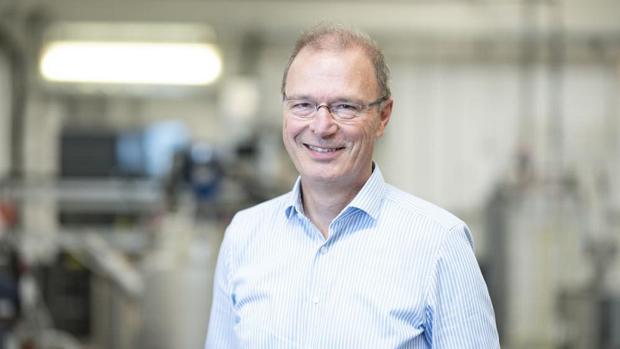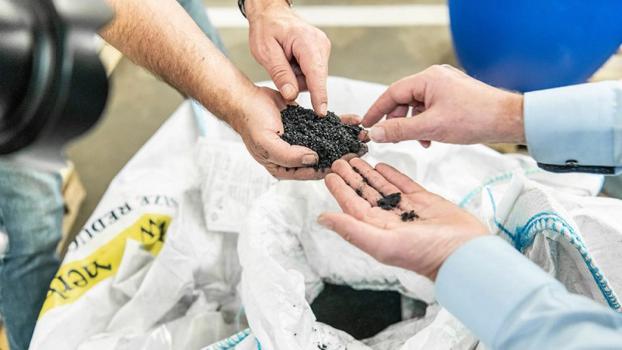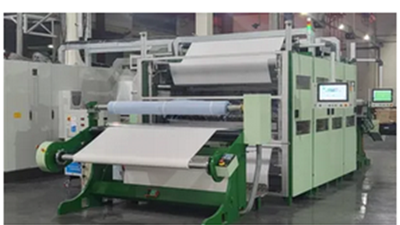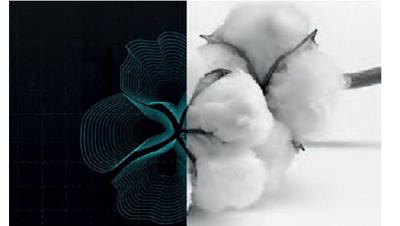Interview with Carsten Eichert, Rittec Umwelttechnik

Carsten Eichert (Source: Rittec/Mathias Mensch Borowiakziehe)
Textiles containing polyester do not have a good reputation, although studies show that the overall eco-balance of polyester is better than that of natural fibers such as cotton. The fact that polyester is not degradable is particularly criticized. This makes a functioning collection and high-quality recycling of such textiles all the more important. There is currently no circular economy for polyester. In this interview with K-MAG, Carsten Eichert, founder and managing director of Rittec Umwelttechnik GmbH, Lüneburg/Germany, talks about the challenges of recycling textiles containing polyester.
Up to now, only a small proportion of textiles have been recycled to a high standard. What is the reason for this?
Textiles usually consist of a variety of materials. Even a shirt made of 100% cotton is usually sewn with a nylon thread. In addition, different colors, additives and finishing materials are used, which make material recycling, i.e. mechanical recycling, impossible. Especially in the post-consumer waste stream, there is a heterogeneous mix of materials that cannot be separated by type with the existing sorting techniques (almost exclusively manual sorting!) in such a way that mechanical recycling would be possible.
Mechanical recycling is dependent on very clean input streams, such as those found in PET bottle recycling. The textile industry cannot offer this. Therefore, this type of recycling is largely ruled out, especially if a larger proportion of synthetic fibers is involved. For pure cotton products, recycling is now possible, but also under strict quality requirements for the supplier industry.
Textiles usually consist of a variety of materials. Even a shirt made of 100% cotton is usually sewn with a nylon thread. In addition, different colors, additives and finishing materials are used, which make material recycling, i.e. mechanical recycling, impossible. Especially in the post-consumer waste stream, there is a heterogeneous mix of materials that cannot be separated by type with the existing sorting techniques (almost exclusively manual sorting!) in such a way that mechanical recycling would be possible.
Mechanical recycling is dependent on very clean input streams, such as those found in PET bottle recycling. The textile industry cannot offer this. Therefore, this type of recycling is largely ruled out, especially if a larger proportion of synthetic fibers is involved. For pure cotton products, recycling is now possible, but also under strict quality requirements for the supplier industry.
You have now developed a process with which mixed materials containing polyester can be recycled. How does the process work?
Our revolPET process is based on a simple chemical reaction: the reaction of the polyester polymer with a metal hydroxide. This reaction splits the polyester polymer into a monoethylene glycol and a metal terephthalate. The polyester polymer is depolymerized. Both products obtained are basic chemicals needed for the production of new polyester. The reaction of the polyester with the metal hydroxide is described in various patents and publications, so it is nothing new. Our innovation is that we were able to integrate this reaction into a continuous process. In this way, we realize advantages in process control as well as in terms of efficiency.
What, in particular, was the challenge in the development?
The particular challenge was to identify the technology approach for continuous depolymerization in order to enable the option of economies of scale.
Only through economies of scale, i.e. the reduction of the relative costs per target unit by increasing the throughput, for example, does it become realistic to realize depolymerization and thus the recycling of polyester fibers economically. The depolymerization released by us in an extruder also enables the direct use of reaction energy that is released. This reaction energy is generated by the reaction of the metal hydroxide with the polyester molecule. In our revolPET process, we do not let this released energy escape, but use it directly in the reaction chamber for the subsequent reactions. This makes our process extremely energy-efficient and thus also ecologically advantageous.

(Source: Rittec/Mathias Mensch Borowiakziehe)
What potential does this technology have? Where can it be used in the future?The revolPET technology can process different input streams. It can also be a mix of different PET/polyester products that are to be brought to the depolymerization of the polyester. The reaction is a strictly selective one, which means that the non-polyester parts in the input stream do not react or react only very little and are present as solids after the depolymerisation step. This allows for easy and good separation with the result that other materials in the input mix, for example cotton fibres, can be isolated and sent for further recycling.
Our technology is to be used globally. Wherever PET or polyester waste is produced, a revolPET plant can be located. Thanks to advantageous process parameters, very large capacities are not necessary to operate the technology profitably. From an annual capacity of about 15,000 tons/annum onwards, it can be assumed that the operation is profitable. One prerequisite is that at least 75% of the input stream is polyester or PET.
To what extent do you contribute to climate protection in this way?
The production of new polyesters and thus also their basic chemicals, which we produce with our technology, is currently done from fossil raw materials. The production of one ton of terephthalic acid causes 1.8 tons of CO2 equivalents. The revolPET technology produces it with only 0.7 tons CO2 equivalents. In addition, we get the raw material that can be used again for new products. The recycling of PET with this technology can be repeated as often as desired. This is how we realize complete circularity of polyester.
The complete substitution of fossil-based raw materials by recycled raw materials or secondary raw materials is in itself climate-friendly. By saving energy and thus reducing CO2 emissions compared to the crude oil-based production route, our process contributes to climate protection. The results have been confirmed by an LCA carried out by the TU Braunschweig according to strict scientific criteria.
revolPET = registered trademark
This interview first appeared on https://mag.k-online.de/
This interview first appeared on https://mag.k-online.de/



